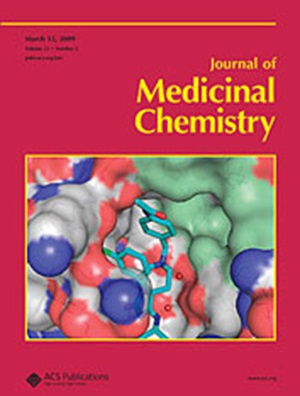Free Drug Concepts: A Lingering Problem in Drug Discovery
IF 6.8
1区 医学
Q1 CHEMISTRY, MEDICINAL
引用次数: 0
Abstract
The concepts, while not complex, can be counterintuitive. The processes governing free drug concentrations in vivo are different from those in in vitro assays but are often assumed to be the same. The most common calculation performed (conversion of total drug concentration to free drug concentration) requires an equation in a form that, while mathematically correct, has led to a mechanistic misunderstanding. This misunderstanding results in many published studies being incorrect in their use of pharmacokinetic data as drivers of compound optimization. Pharmacokinetic training focuses on total drug concentrations and parameters, and these also dominate clinical pharmacokinetics where the focus is on a single compound, and for which plasma binding is usually constant. Compound optimization in drug discovery is anchored on the understanding of unbound drug exposure and its relationship to target engagement; thus, comparisons between molecules requires the use of unbound exposure and unbound PK parameters. Even today, authors use the term “Free drug hypothesis”, as though there is some doubt as to its validity. It is not a hypothesis; it is a fundamental principle. Unbound drug concentrations at the target site determine the degree of target engagement Unbound concentrations in vivo are not determined by the extent of plasma or tissue binding; instead, plasma and tissue binding determine the concentrations of bound drug Unbound drug concentrations in vivo are determined by the rate of drug input (absorption) and the rate of elimination (intrinsic clearance) At equilibrium, free drug concentrations in cytosol approximate those in plasma (with a few specific exceptions, described below Figure 1. Clearance terms derived from in vitro and in vivo experiments and their relationships Note: CLint is, by definition, an unbound term and thus CLint measured in vitro is an apparent value until corrected for binding in the assay. However, for the avoidance of doubt, we have used CLint,u to represent the binding-corrected in vitro value. Figure 2. Effect of increasing dose on the total and free AUC and clearance for ceftriaxone. Figure 3. Simulations demonstrating influence of plasma protein binding on pharmacokinetic parameters. Figure 4. Mean Kpuu (solid bars) and Kp for neutral, acidic (mainly ionised at pH 7.4) and basic drugs (mainly ionised at pH 7.4). Data replotted from Mateus et al. (11) In vivo, protein binding and free fraction have no effect on free drug concentration for oral drugs at steady-state. For oral drugs, intrinsic clearance is the key determinant of free drug concentrations in plasma and tissues. In vitro potency assays represent a closed, static system in which nonspecific binding determines the free drug concentration, and should be corrected for. The only reason to measure fraction unbound in plasma is to convert total plasma concentrations/parameters to free concentrations/parameters. In most situations, free drug concentrations in plasma can be used as a surrogate for free drug concentrations at the site of action. Optimizing for low dose and acceptable dose frequency requires the appropriate balance between unbound exposure and unbound potency, and plasma protein binding has no impact on either of these. clearance intrinsic clearance intrinsic clearance corrected for binding to in vitro system unbound clearance fraction unbound in plasma fraction unbound in tissues ratio of concentrations in tissue and plasma ratio of unbound concentrations in tissue and plasma volume of distribution volume of distribution at steady-state unbound volume of distribution at steady-state This article references 11 other publications. This article has not yet been cited by other publications.

免费药物概念:药物发现中的一个遗留问题
这些概念虽然并不复杂,但可能有悖常理。体内游离药物浓度的作用过程与体外检测不同,但通常被假定为相同。最常用的计算方法(将药物总浓度转换为游离药物浓度)需要一个方程式,虽然数学上是正确的,但却导致了机理上的误解。这种误解导致许多已发表的研究在使用药代动力学数据作为化合物优化的驱动力时出现错误。药代动力学培训的重点是药物的总浓度和参数,这些也是临床药代动力学的主要内容,而临床药代动力学的重点是单一化合物,其血浆结合力通常是恒定的。药物发现中的化合物优化基于对非结合药物暴露及其与靶点参与关系的理解;因此,分子间的比较需要使用非结合暴露和非结合 PK 参数。时至今日,仍有学者使用 "游离药物假说 "这一术语,似乎对其有效性存有疑问。这不是一个假设,而是一个基本原则。体内未结合药物浓度并不取决于血浆或组织结合的程度;相反,血浆和组织结合决定了结合药物的浓度 体内未结合药物浓度取决于药物输入(吸收)速度和消除(内在清除)速度。根据体外和体内实验得出的清除率术语及其关系 注:CLint 的定义是未结合术语,因此体外测得的 CLint 只是一个表观值,直到在化验中根据结合情况进行校正。不过,为避免疑义,我们使用 CLint,u 表示结合校正后的体外值。图 2.剂量增加对头孢曲松总AUC和游离AUC以及清除率的影响。图 3.模拟显示血浆蛋白结合对药代动力学参数的影响。图 4.中性、酸性(主要在 pH 值为 7.4 时电离)和碱性(主要在 pH 值为 7.4 时电离)药物的平均 Kpuu(实条)和 Kp。在体内,蛋白质结合和游离部分对口服药物在稳态时的游离药物浓度没有影响。对口服药物而言,内在清除率是决定血浆和组织中游离药物浓度的关键因素。体外药效测定是一个封闭的静态系统,其中非特异性结合决定了游离药物浓度,因此应进行校正。测量血浆中未结合部分的唯一原因是将血浆总浓度/参数转换为游离浓度/参数。在大多数情况下,血浆中的游离药物浓度可作为作用部位游离药物浓度的替代物。要优化低剂量和可接受的给药频率,就必须在非结合暴露和非结合效力之间取得适当平衡,而血浆蛋白结合对这两者均无影响。本文尚未被其他出版物引用。
本文章由计算机程序翻译,如有差异,请以英文原文为准。
求助全文
约1分钟内获得全文
求助全文
来源期刊

Journal of Medicinal Chemistry
医学-医药化学
CiteScore
4.00
自引率
11.00%
发文量
804
审稿时长
1.9 months
期刊介绍:
The Journal of Medicinal Chemistry is a prestigious biweekly peer-reviewed publication that focuses on the multifaceted field of medicinal chemistry. Since its inception in 1959 as the Journal of Medicinal and Pharmaceutical Chemistry, it has evolved to become a cornerstone in the dissemination of research findings related to the design, synthesis, and development of therapeutic agents.
The Journal of Medicinal Chemistry is recognized for its significant impact in the scientific community, as evidenced by its 2022 impact factor of 7.3. This metric reflects the journal's influence and the importance of its content in shaping the future of drug discovery and development. The journal serves as a vital resource for chemists, pharmacologists, and other researchers interested in the molecular mechanisms of drug action and the optimization of therapeutic compounds.
 求助内容:
求助内容: 应助结果提醒方式:
应助结果提醒方式:


